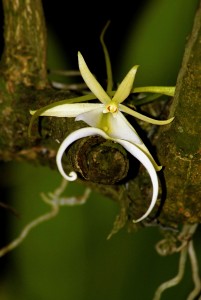 Orchids are quite an exotic flower, so it’s no surprise that they can be found in one of the most mystical places in the world: The Everglades. Seeing these Everglades orchids is like finding beauty in an unexpected place, since the area widely known for its green and swampy colorings. According to the National Park Service, the diversity of orchids in the Everglades is higher than any other National Park in the United States.
Orchids are quite an exotic flower, so it’s no surprise that they can be found in one of the most mystical places in the world: The Everglades. Seeing these Everglades orchids is like finding beauty in an unexpected place, since the area widely known for its green and swampy colorings. According to the National Park Service, the diversity of orchids in the Everglades is higher than any other National Park in the United States.
Orchids have the largest variety within their family of flowers, and they all vary in color and size. They are also a really old species of plant; there are fossils of orchids and orchid pollen showing that they have existed on the planet for around 100 million years. It is believed that many of the Everglades orchids originated from the West Indies from winds blowing seeds.
Types Everglades Orchids
Thirty-nine orchid species live in the Everglades. All of them have different months in which they bloom. Some types include: grass pink orchid (Calopogon tuberosus), longclaw orchid (Eltroplectis calcarata), butterfly orchid (Encyclia tampensis), clamshell orchid (Prosthechea cochleata var. triandra) and the ghost orchid (Polyriihiza lindenii).
The longclaw orchid is a tropical species; it is very small and its flower is white in color with green and brown-spotted leaves. It is found often alongside streams. The butterfly orchid sprouts a bunch of small, yellow-petal flowers off from grass-like, green leaves; they are often found in trees. The grass pink orchid has small flower that range in color from white to pink or a mix of both with a few green grass-like leaves on each plant; each plant can have up to 10 flowers on it. The clamshell orchid has a dark-colored flower with white and yellow colors in the inside of flower. Underneath the flower, thin, green tepals hang down. The ghost orchid is a leafless orchid with one, somewhat large white flower.
Orchid Habitats
Where can these colorful orchids be found? Being a warm and humid climate, many of the orchid species live on trees in the Everglades. These orchids are considered to be epiphytic plants that take nutrients from the air, rain and other debris around it; they do not harm the plant they are growing on. Orchids can be found on the trunks of pop ash, live oak, royal palm, cypress pond apple trees, and wet prairies and roadsides.
Saving the Orchids
Due to climate change and human interference, the Everglades have been suffering. Rising sea levels, years of dredging, population increases and development have compromised the environment and size of the Everglades. Not only is their habitat decreasing in size, but Everglades orchids have been threatened by visitors in the park for quite some time. For many years, collectors and tourists would pick the plants for a collection or to sell, according to the National Park Service. The orchids were overharvested. The Park Service says it is believed at least three orchid species became extinct within the park due to over picking; rare species were often chosen to bring home for their value. Now, the collection of orchids, and all plant and wildlife, in the Everglades is prohibited. Several biologists have made it their mission now to save endangered orchids, like the cigar orchid. By bringing seeds of the plant to a greenhouse and transporting plants, biologists are helping restore the in the wetland area.
Seeing the Everglades Orchids
For a chance at spotting some of rare and stunning Everglades orchids, an airboat tour is a great way to travel around different plant life that the orchids can be growing on. The airboats give people the chance to enter parts of the Everglades not accessibly by foot. To check out the orchids and hundreds of other plants in the Everglades, book an airboat ride today!






